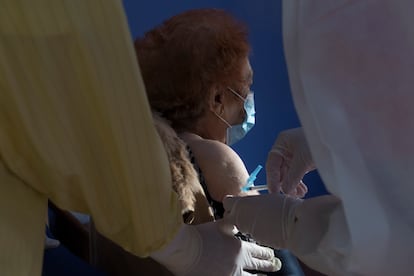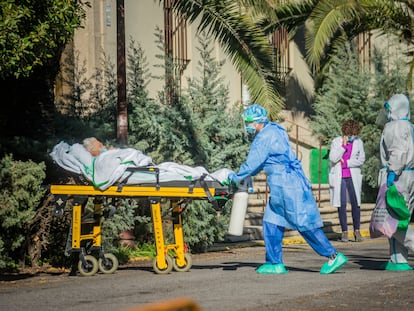In Spain, people over 70 may start getting coronavirus vaccine by March
With Phase 1 of the campaign underway, health authorities are about to define the groups that are next in line to receive their inoculations

Spain’s Health Ministry and regional governments are working out the details of the next stage of the coronavirus vaccination campaign. Following a first phase that includes care home residents, healthcare workers and people with severe disabilities who are not in care facilities, next in line to get their shots are the 70-and-older group.
If the current pace of delivery keeps up, this new phase could begin in March, although the start date may be pushed forward or back depending on the speed of shipment deliveries and whether new vaccines get approved, said sources familiar with the situation.
The age brackets are expected to be decided on Wednesday at a meeting of central and regional health officials known as the Inter-Territorial Council of the National Health System (CISNS). Although this is a national strategy, some regional governments such as Andalusia and Navarre have already announced their plans to start vaccinating their older citizens next.
Immunizing healthcare workers is proving to be a fast process, as they are easy to locate, but reaching the general population may prove slower
There are around 6.8 million people over the age of 70 in Spain, although of these, approximately 380,000 live in care homes and are in the process of being inoculated. People included in the next group will be notified by their local healthcare center for an appointment, and those who are physically unable to go will receive a home visit by a nurse.
“It will be a very similar process to how the flu vaccine is administered,” said a regional source.
Amós García Rojas, president of the Spanish Vaccinology Society and a member of the committee in charge of designing the national vaccination plan, explains that it would make sense to first give appointments to the 90-and-over population, followed by the 80-to-90 group and then those 70 and over.
“After them, we would move on to people with high-risk conditions in other age brackets,” he said, alluding to a group made up of around eight million people.
According to García Rojas, next in line after that could be essential workers (5.3 million counting educators), although everything will depend on the number of available doses – if there are enough, some groups may overlap.
Vulnerable elders
Priority is being given to elders because of their vulnerability: 66.5% of all official Covid-19 deaths during the second wave were people over the age of 80, even though this age group only accounts for six percent of Spain’s population. If we add the 70-plus group, the Covid-19 fatality rate shoots up to above 86%, according to figures from the Carlos III Health Institute.
In other words, with similar levels of infection, if this entire population gets immunized, it should lead to almost nine times fewer deaths from coronavirus.
This is why the European Commission (EC) on Tuesday set a March goal for member states to vaccinate at least 80% of health and social care professionals as well as 80% of people over the age of 80. By summer, member states should have vaccinated a minimum of 70% of the adult population, said the EC in a statement.
In Germany and the United Kingdom, inoculations began simultaneously for care home residents and people over the age of 80. In France, citizens 75 and over with a high-risk condition began getting their shots on Monday. But people were in charge of making their own appointments, leading to overburdened systems.
Logistical challenge
García Rojas believes that such a problem can be avoided in Spain. “The public healthcare system is strong, and people can be easily located through their medical history. It’s true that this is a very complex vaccination because of the size of the population and the logistics involved, which are different from those for the regular vaccines administered routinely in Spain,” he said.
Pedro Gullón, of the Spanish Epidemiology Society, noted that immunizing healthcare workers is proving to be a fast process, as they are easy to locate, but reaching the general population may prove slower.
As part of the first phase, which is still underway, the next people in line for shots are healthcare workers who are not on the frontlines, as well as people with severe disabilities who are not living in long-term care centers (those who are have already been vaccinated). Immunizing this latter group will test the logistical capabilities of the healthcare system, as teams of nurses will have to be dispatched to homes to administer the vaccine.
According to the latest Health Ministry data, regional governments have received 1.1 million doses, of which 966,097 (84.5%) have been administered. The goal for the first phase is to immunize around 2.5 million people: 1.7 million healthcare workers, 380,000 residents of care homes, and 367,000 people with severe disabilities who are not in care facilities.
With reporting by Guillermo Abril, Silvia Ayuso and Elena G. Sevillano.
English version by Susana Urra.
Tu suscripción se está usando en otro dispositivo
¿Quieres añadir otro usuario a tu suscripción?
Si continúas leyendo en este dispositivo, no se podrá leer en el otro.
FlechaTu suscripción se está usando en otro dispositivo y solo puedes acceder a EL PAÍS desde un dispositivo a la vez.
Si quieres compartir tu cuenta, cambia tu suscripción a la modalidad Premium, así podrás añadir otro usuario. Cada uno accederá con su propia cuenta de email, lo que os permitirá personalizar vuestra experiencia en EL PAÍS.
¿Tienes una suscripción de empresa? Accede aquí para contratar más cuentas.
En el caso de no saber quién está usando tu cuenta, te recomendamos cambiar tu contraseña aquí.
Si decides continuar compartiendo tu cuenta, este mensaje se mostrará en tu dispositivo y en el de la otra persona que está usando tu cuenta de forma indefinida, afectando a tu experiencia de lectura. Puedes consultar aquí los términos y condiciones de la suscripción digital.
More information
Últimas noticias
Most viewed
- Sinaloa Cartel war is taking its toll on Los Chapitos
- Oona Chaplin: ‘I told James Cameron that I was living in a treehouse and starting a permaculture project with a friend’
- Reinhard Genzel, Nobel laureate in physics: ‘One-minute videos will never give you the truth’
- Why the price of coffee has skyrocketed: from Brazilian plantations to specialty coffee houses
- Silver prices are going crazy: This is what’s fueling the rally











































